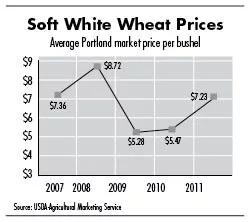Commodity markets mostly look favorable

Prospects look generally positive for commodities produced in the Inland Northwest, although wheat—an important crop here—could face some tough challenges in the coming year.
Phil DiPofi, president and CEO of big Spokane-based ag lender Northwest Farm Credit Services, was bullish in a recent interview, saying the industry is positioned well—despite some volatile times ahead—to continue along a mostly upward track.
While the majority of wheat farmers reported average to above-average crop yields this year, current selling prices for wheat are slightly above the crop's production costs, local agriculture experts say.
Other Inland Northwest crops, including potatoes, hay, and legumes, saw a diverse yield mix, and the market outlook on those crops for 2012 varies.
A drought in Russia and other parts of eastern Asia last year caused U.S. wheat prices to rise, while farmers in the region now are barely netting a profit, says Tom Mick, Spokane-based president of the Washington Grain Commission.
A worldwide rebound in wheat production since last year's harvest season, though, is contributing to a decline in U.S. exports to some countries, Northwest Farm Credit Services reports in a commodities update it issued last month.
The lender also says that many Northwest farmers still own most of their crops harvested this year and are holding out for an improved selling market. Also, rising fuel and fertilizer costs might compress producers' margins, with breakeven prices nearing $6 a bushel, it says.
Soft white wheat prices averaged about $6 a bushel last month for exports out of Portland, Ore., the U.S. Department of Agriculture reports, down from about $6.30 a bushel for the same month in 2010.
Mick says the outlook for the region's wheat crop in 2012 will depend largely on the success of U.S. export competitors' harvests in the southern hemisphere.
Potato farmers in Washington and Idaho planted about 10 percent more crop acres this year, which Northwest Farm Credit says was mostly due to larger contracts with potato processers for this year's harvest and higher fresh market prices for the 2010 crop harvest.
An increased supply of potatoes from this season's harvest are anticipated to depress prices and growers' profits for next year's harvest, but the ag lender reports that potato growers remain bullish.
The Palouse-area legume crops—peas, lentils, and chickpeas—saw average to above-average yields for this year's harvest, and prices remain mostly steady, says Todd Scholz, director of information and research for the Moscow, Idaho-based U.S.A. Dry Pea & Lentil Council.
A crop to watch, he says, is chickpeas, which are the main ingredient in hummus spread, which is in high demand.
Prices per pound for chickpeas have risen to around 50 cents a pound from 26 cents a pound during spring planting season, Scholz says. Next year, he says, pea growers in the Palouse might plant more chickpeas than green or yellow peas.
Northwest hay growers now are experiencing strong prices, which Northwest Farm Credit's report says is due to a severe shortage of the feed due to drought in other parts of the U.S.
Prices for Washington-grown alfalfa this October increased by 85 percent compared with the prior year, and the average price per ton this fall was around $240.
The demand from cattle and dairy sectors for Northwest-grown hay is predicted to remain high through 2012 and possibly even into 2013, the ag lender reports.
Related Articles

_c.webp?t=1763626051)
_web.webp?t=1764835652)

